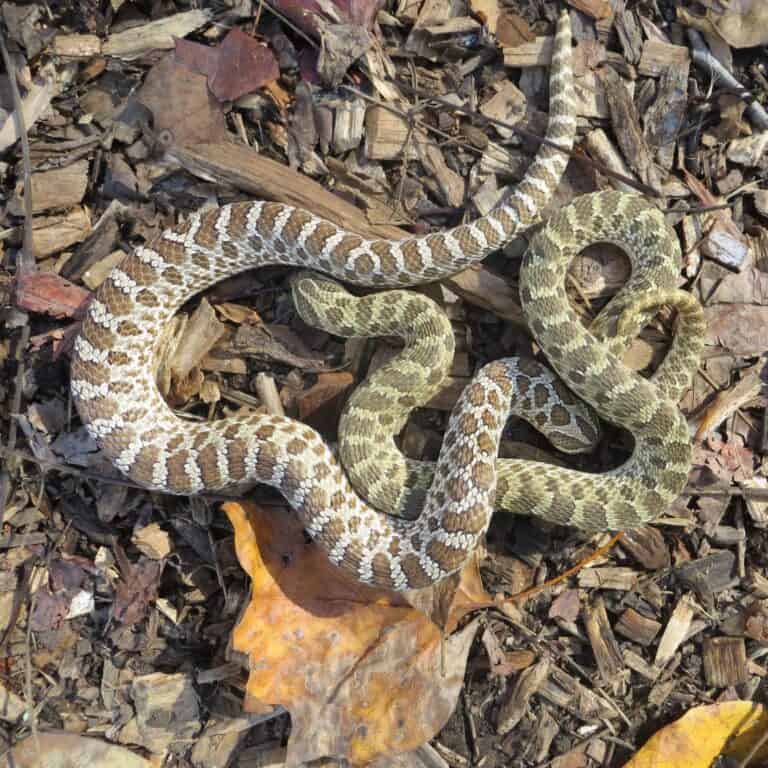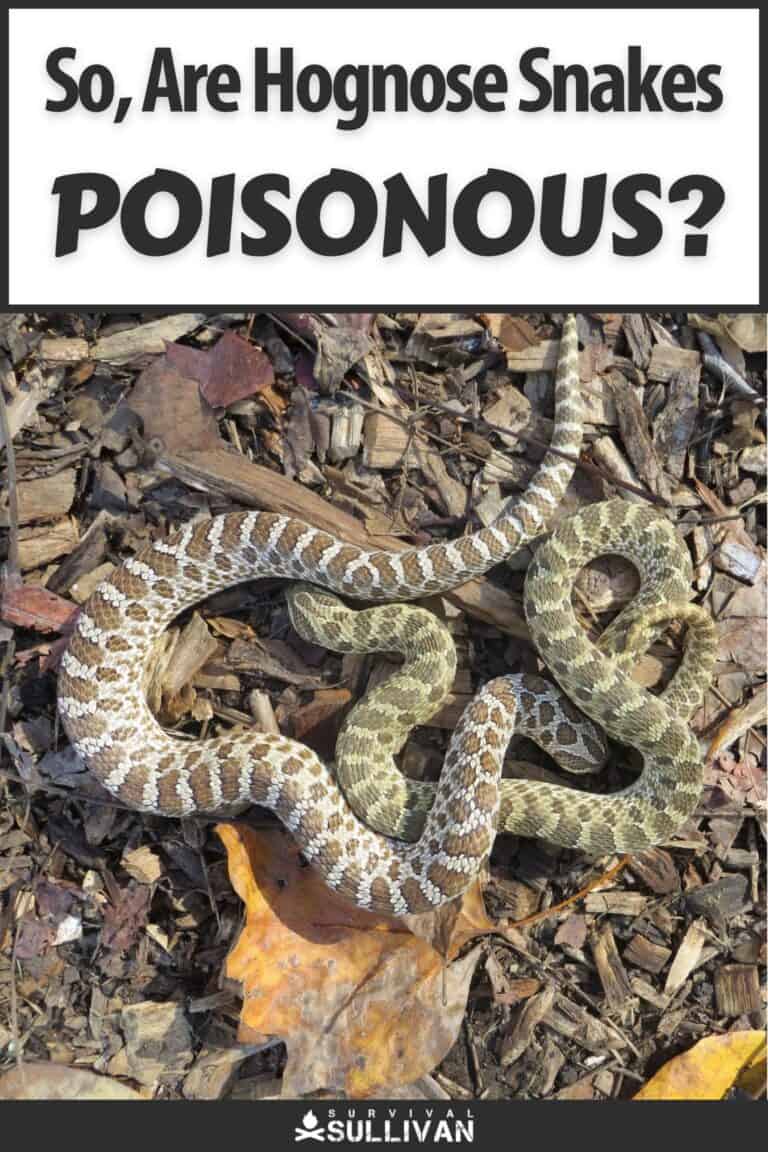Of all the snakes that you might encounter in the wild, some of the most troubling are those with spectacular and scary threat displays, or else ones that look very much like deadly poisonous species.

Sadly, these snakes are usually killed out of hand, or worse, the more dangerous variety is mistaken for a harmless one.
Knowing your snakes is a great way to prevent trouble one way or the other. How about the hognose snake? Is the hognose snake poisonous?
Yes, hognose snakes are technically poisonous, possessing poisonous saliva instead of true venom. However, this toxic saliva is only mildly irritating to humans, and no human deaths from bites have ever been reported.
Depending on which part of the United States you live in, hognose snakes might be extremely common or at least present in your area.
They are all over! And you’d better know a little bit about them because believe me, their threat display is extremely impressive. Keep reading if you want to learn more about these snakes.
Appearance of the Hognose Snake
There are several species of hognose snake found around the world, and in the United States alone there are several subspecies.
Identification can be tricky, because even among these native subspecies colors and patterns are highly variable.
The general characteristics of the snake is one that is of stout build with a prominent, rakish spade-shaped head, round eyes, and round pupils, that has a notably upturned snout which gives the snake its name.
This snout has a reinforced scale that helps the hog nose dig through soil and sand when required. Adults average a little more than 2 ½ feet in length, with massive specimens topping out around 4 ft long.
But back to the coloration and patterns, hognose snakes present in North America can be any color from gray or black to various shades of brown, red, and even green or orange, and any combination of those colors as the base color.
Subsequent patterning may be striped, striated, blocked, blotched, checkered or some other combination.
The underside of the snake is less variable, and trends towards solid, pale, or pastel colors, most often off-white, pale yellow or a solid sky gray.
The underside of the tail is usually noticeably lighter than the rest of the snake’s belly.
Is the Hognose a Venomous Snake?
Strictly speaking, and in the most scientific terms, a hog nose is not a venomous snake because the poisonous saliva that it secretes is not venom which is delivered hypodermically through specialized fangs.
This poisonous saliva is secreted by a distinct gland behind the snake’s eyes called Duvernoy’s gland. Yes, the snake uses this venomous saliva to help dispatch its prey before swallowing it whole.
We usually see the hog nose snake characterized as non-venomous, scientifically, because it does not create and inject true venom.
We also see the hog nose characterized as non-venomous in layman’s terms because the poisonous saliva does not really pose any danger to humans.
At this point, it is a topic where it is easy to split hairs, so make of that information what you will.
Where do Hognose Snakes Live?
Various subspecies of the hognose snake are found all throughout the United States and into the extreme southern reaches of Canada, but there are most prominent west of the Mississippi River.
The snake tends to live in areas with sandy, loose soil, and particularly prefers the edges of pine forests, overgrown fields, and any other place where it has easy digging so it can create burrows for rest, brumination, and egg laying.
Will a Hognose Snake Bite You?
Yes, a hog nose snake will bite you if it is threatened and you persist in bothering it. However, the hognose is most famous, or rather infamous, for its spectacular and showy defensive displays.
When cornered or aggravated, a hog nose will flatten out its head and neck very much like a cobra before lifting up off the ground and loudly hissing.
At this point, it will usually engage in mock strikes or head-butts that are intended to get predators and other threats to head in the other direction. Even in cases of contact, it usually does not bite at this point.
If the threat persists, many hog noses will play dead, rolling over onto their back and sticking their tongue out in a borderline cartoonish display, even letting its tongue hanging out of its head!
Like many snakes, it will also discharge a nasty secretion from its anus to further discourage predators from eating it.
Once the hognose is convinced that the predator is no longer watching it, it will spring back to life and try to get away.
this plane dead it usually persists even when the snake is handled, to the degree that it will roll back over onto its back, belly up, if you care to roll it right side up while it is engaging in this behavior. It is almost like a childish temper tantrum if you ask me.
At any rate, if you were somehow persistent in bothering the snake or it truly felt like it had no other option, then it might bite you.
Is the Bite of the Hognose Painful?
It can be. Hognose snakes are not truly venomous, but regardless they have several rows of sharp, hooked teeth designed to help them secure prey. These teeth are easily capable of cutting your skin.
Now, for all practical purposes, yes, the hog nose snake is indeed poisonous, but this poisonous saliva is incredibly mild, barely an irritant to humans.
People who are bitten by a hognose snake, which is very rare by the way, usually report just a little bit of pain, itching, tingling, a pins and needles sensation, and some mild swelling. Most bites do not require the medical intervention of any kind.
That being said, a bite from any animal but particularly a reptile runs a high likelihood of infection.
You should make it a point to thoroughly clean a bite from any snake, including a hog nose, and if you notice any pronounced swelling, pain, redness or other symptoms of infection don’t hesitate to go get medical attention.
A nasty bacterial infection could be far worse than this snake’s meager poison!
Are Hognose Snakes Aggressive Toward Humans?
No, not at all, though you might think otherwise when you see how ferocious they act during the first phase of their defensive display.
Hognose snakes generally want to be left alone to hunt and eat and sun and don’t want one single thing to do with human beings or larger animals that might kill them deliberately or accidentally.
Even if you notice a hog nose snake flattening out its neck in that distinctive, hooded appearance and striking towards you, you can rest easy knowing it is just trying to scare you off so it can get back to its day.
Is the Hognose Snake Aggressive Toward Pets and Livestock?
No. Most hognose snakes and in particular the Eastern hognose snake are prolific predators of amphibians, particularly frogs and toads, but rodents are also frequently on the menu.
However, some hognose snakes have been known to periodically feed on eggs, so you should be cautious if you have chickens with young chicks around.
Now, hognose snakes do not pose any threat whatsoever to larger animals, not directly, but many barnyard animals are terrified of snakes and a stampede is not out of the question.
You will want to avoid allowing any snakes, including hognose snakes, to be around your animals.
Should You Kill Hognose Snakes?
No, not if you have any other choice. Hognose snakes are ultimately harmless despite all of their blusters, and they play an important role in the food chain, both as predators and as prey.
If at all possible, you should try to relocate a hog nose snake that is being a pest, and if you aren’t up to the task yourself feel free to contact animal control, a reptile rescue, or even the herpetology department at a nearby university.


Tom Marlowe practically grew up with a gun in his hand, and has held all kinds of jobs in the gun industry: range safety, sales, instruction and consulting, Tom has the experience to help civilian shooters figure out what will work best for them.
